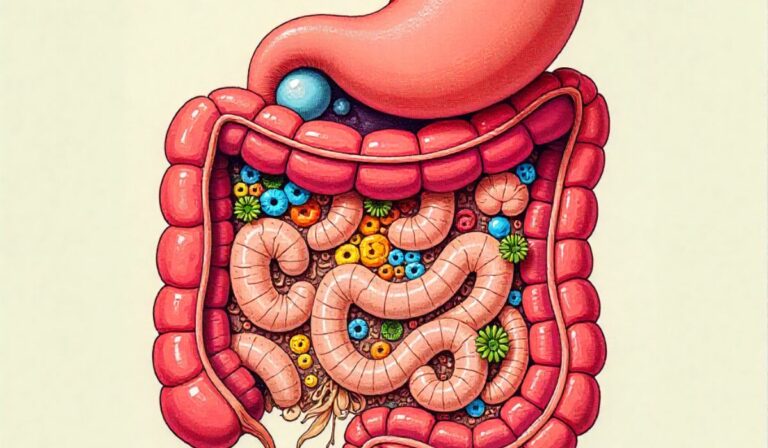Fecal Microbiota Transplant (FMT): Exploration, Challenges & Practical Usage
Imagine your gut is like a garden, and sometimes, the bad weeds – harmful bacteria – take over. This can lead to serious health problems.
But what if you could introduce healthy “seeds” to rebalance things? That’s the basic idea behind Fecal Microbiota Transplant (FMT).
This procedure is generating interest, and perhaps offering a solution, for certain gut-related issues.
In this post, we’ll explore the science, the good and bad points, and how FMT is being used in the real world. You’ll learn about the potential benefits and the possible risks, giving you a complete overview of this complex subject.
Key Takeaways
![Fecal Microbiota Transplant (FMT) Exploration, Challenges & Practical Usage[2]](https://mycleanseplan.com/wp-content/uploads/2025/10/Fecal_Microbiota_Transplant_FMT__Exploration_Challenges__Practical_Usage2.jpg)
What is Fecal Microbiota Transplant (FMT)?
The gut, also known as the gastrointestinal tract, is home to trillions of microorganisms, collectively called the gut microbiome.
These microorganisms, including bacteria, viruses, fungi, and archaea, play a vital part in digestion, immunity, and overall health.
When the balance of these microorganisms is disrupted, leading to an imbalance known as dysbiosis, it can cause various health problems.
Fecal Microbiota Transplant (FMT) is a medical procedure designed to restore this balance. It’s essentially a transplant of fecal matter from a healthy donor into the gut of a patient.
The Microbiome: Your Gut’s Ecosystem
The gut microbiome is like a bustling city within your body, filled with diverse communities of microbes.
Each type of microbe has a role, working together to keep things running smoothly. This complex ecosystem is essential for many bodily functions.
For example, it helps to digest food, absorbs nutrients, and provides protection from harmful pathogens.
It also contributes to the production of vitamins, and influences the immune system. A healthy and diverse microbiome is key for maintaining overall well-being.
Several factors, including diet, medications (especially antibiotics), and lifestyle, can affect the composition and function of the gut microbiome.
- Diversity of Microbes: A healthy gut microbiome contains a wide variety of different microbial species. Diversity ensures that various functions are carried out efficiently and helps the gut resist infections. For example, some bacteria aid in the fermentation of fiber, producing short-chain fatty acids (SCFAs) that are important for gut health.
- Barrier Function: The gut microbiome helps to maintain the integrity of the intestinal lining, acting as a barrier against harmful substances. This barrier prevents pathogens and toxins from entering the bloodstream and causing inflammation. Certain bacteria, like those that produce mucus, are essential for maintaining this barrier function.
- Immune System Modulation: The gut microbiome communicates with the immune system, training it to distinguish between friend and foe. This helps to prevent overreaction to harmless substances and to fight off infections. For instance, the presence of certain bacteria can stimulate the production of antibodies and other immune cells.
- Metabolic Activity: The gut microbiome plays a key role in metabolism, affecting how the body processes food and stores energy. It breaks down complex carbohydrates, synthesizes vitamins, and helps to extract energy from food. This metabolic activity is influenced by the types of bacteria present in the gut.
The FMT Process: Step by Step
The process of FMT involves several carefully controlled steps to ensure safety and effectiveness. The goal is to introduce a healthy and diverse community of gut bacteria into the patient's colon to restore balance and improve gut health.
The process is not as simple as it may sound, requiring detailed screening of the donor, careful preparation of the recipient, and precise delivery of the donor material.
- Donor Screening: The first step is to identify a suitable donor. The donor undergoes a thorough screening process that includes health questionnaires, physical examinations, and extensive testing to rule out infections and other health conditions that could be transmitted to the recipient. Blood tests are performed to screen for infectious diseases like HIV, hepatitis, and syphilis. Stool samples are analyzed to detect the presence of pathogens, parasites, and abnormal bacteria.
- Preparation of the Donor Material: Once a healthy donor is approved, their stool is collected and processed. The stool is mixed with a saline solution and filtered to remove solid particles, resulting in a liquid suspension containing the bacteria. This suspension is then prepared for delivery. The process is done quickly to preserve the viability of the bacteria.
- Recipient Preparation: The recipient usually undergoes a bowel cleanse to clear the gut and create space for the donor bacteria. Depending on the condition being treated and the method of delivery, the recipient may receive antibiotics to suppress existing gut bacteria. The purpose is to make the environment in the colon more hospitable for the new bacteria.
- Delivery Methods: The prepared donor material is delivered to the recipient’s gut using various methods. These methods include colonoscopy, enema, or via a nasogastric or nasoduodenal tube. The choice of delivery method depends on the condition being treated and the patient’s individual circumstances. The goal is to get the bacteria to the colon where they can colonize and begin to restore balance.
- Follow-up Care: After the FMT procedure, the patient is carefully monitored for any adverse reactions or side effects. The healthcare team may also monitor the patient’s gut microbiome to assess the effectiveness of the transplant. The patient is advised to follow specific dietary guidelines to support the growth and establishment of the donor bacteria. Additional FMT procedures may be required for optimal results.
Who is a Good Candidate for FMT?
While research continues to explore the uses of FMT, it’s not a universal treatment. The suitability for FMT is carefully evaluated.
It is not something one can decide on their own. Each patient’s needs and current condition is evaluated to ascertain whether FMT can offer any positive health outcome.
Some individuals might find the procedure more useful than others. Before considering FMT, patients undergo a thorough medical evaluation, including a review of their medical history, physical examination, and diagnostic tests.
- Recurrent Clostridioides difficile Infection (rCDI): This is the most common and well-established use of FMT. FMT has been shown to be highly effective in curing rCDI when antibiotics have failed. Patients with multiple episodes of CDI are strong candidates.
- Inflammatory Bowel Disease (IBD): Some studies have suggested that FMT may be helpful for IBD, including ulcerative colitis and Crohn’s disease. However, the evidence is still emerging, and FMT is not yet a standard treatment. Patients who haven’t responded to other treatments may be candidates.
- Irritable Bowel Syndrome (IBS): FMT is being investigated as a possible treatment for IBS. The effects have been mixed, but some patients have reported improvements in their symptoms. Participation in clinical trials is the primary option for those with IBS.
- Other Conditions: FMT is being explored for other conditions, including metabolic syndrome, autoimmune disorders, and neurological conditions. However, research is still in its early stages, and FMT is not yet a standard treatment for these conditions. Participation in clinical trials remains the primary option for these conditions.
Benefits and Risks Associated With FMT
As with any medical procedure, FMT carries both potential benefits and risks. Weighing these aspects is critical when considering FMT as a treatment option. Understanding these facets helps individuals make informed decisions about their health.
It is not an alternative treatment; this is a medical procedure done under the supervision of a physician.
Potential Benefits of FMT
The main goal of FMT is to restore a healthy balance to the gut microbiome. The beneficial bacteria are transferred.
This can lead to a range of positive health outcomes, especially for those suffering from certain gastrointestinal conditions.
- Treatment of Clostridioides difficile Infection (CDI): FMT has demonstrated significant effectiveness in treating CDI. It can stop recurring infections when antibiotics do not work. Often, it provides a long-term solution by re-establishing a healthy gut microbiome.
- Improvement in IBD Symptoms: In some cases, FMT has shown promise in reducing symptoms of IBD. Patients with ulcerative colitis and Crohn’s disease might experience symptom relief. The effects vary from person to person.
- Possible Relief from IBS Symptoms: Some patients with IBS have reported reduced symptoms after receiving FMT. It can improve abdominal pain, bloating, and changes in bowel habits. Further research is needed.
- Enhanced Gut Health: FMT can improve overall gut health by increasing the diversity and function of the gut microbiome. This can lead to better digestion, nutrient absorption, and immune function. It can improve the production of SCFAs.
Potential Risks and Side Effects
Although FMT has shown impressive benefits, it’s not without risks. Patients should be aware of these potential side effects.
The risks associated with FMT are generally low, but it’s important to understand them and take precautions. It’s also important to have a transparent discussion with a healthcare provider.
- Infection Transmission: There is a small risk of transmitting infectious diseases from the donor to the recipient. Thorough screening of donors helps to minimize this risk. Despite these precautions, transmission is still possible.
- Gastrointestinal Symptoms: Some patients may experience temporary side effects. These can include abdominal pain, bloating, diarrhea, and constipation. These symptoms usually resolve on their own within a few days or weeks.
- Changes in Gut Microbiome: FMT may lead to changes in the composition of the gut microbiome. Although the goal is to restore balance, the changes can sometimes be unpredictable. The effects on the patient’s gut microbiome might vary.
- Rare Adverse Events: Although rare, there have been reports of serious adverse events. These events include severe infections, sepsis, and even death. These adverse events are not common, but can occur, highlighting the importance of careful donor screening and patient monitoring.
FMT in Action: Real-World Examples
While FMT remains a subject of ongoing research, its use in real-world scenarios provides valuable insights into its effectiveness and practical applications.
It is most commonly used for recurrent Clostridioides difficile (rCDI) infections, where it has demonstrated significant success.
It has also shown promise in treating Inflammatory Bowel Disease (IBD) and Irritable Bowel Syndrome (IBS).
However, FMT is a relatively new procedure, and its application varies from one medical center to another.
Case Study 1: Treating Recurrent Clostridioides difficile Infection
Sarah, a 62-year-old woman, suffered from multiple recurrences of Clostridioides difficile infection (rCDI). Each time, she was treated with antibiotics, but the infection kept returning.
Sarah experienced debilitating diarrhea, abdominal cramps, and fatigue, significantly impacting her quality of life.
After consulting with her gastroenterologist, Sarah was advised to undergo FMT. Her donor was a healthy, carefully screened individual.
The procedure was performed via colonoscopy, delivering the donor stool directly into Sarah’s colon. Following the FMT, Sarah experienced significant improvement in her symptoms.
Her diarrhea stopped, her abdominal pain subsided, and her energy levels returned. A follow-up test revealed that her gut microbiome had successfully been repopulated with healthy bacteria from the donor.
Sarah remained free of CDI for over a year after the procedure, reporting a significant improvement in her overall health and quality of life.
- Problem: Multiple recurrences of Clostridioides difficile infection (rCDI).
- Treatment: FMT via colonoscopy.
- Outcome: Significant symptom improvement and eradication of CDI.
Case Study 2: Exploring FMT for Inflammatory Bowel Disease
John, a 45-year-old man, had a long history of ulcerative colitis, a form of IBD. He tried various medications with limited success.
John experienced frequent flare-ups, accompanied by severe abdominal pain, bloody stools, and fatigue.
His doctor suggested he try FMT. After a careful assessment, John received FMT via enema. The donor was a healthy individual.
While John didn’t experience a complete remission of his symptoms, he reported a noticeable improvement in his condition.
His flare-ups became less frequent and less severe. His energy levels increased, and he experienced a reduction in abdominal pain.
While he needed to continue some medication, FMT played a role in managing his IBD symptoms and improving his quality of life. The effects of FMT on IBD can vary.
- Problem: Ulcerative Colitis (IBD).
- Treatment: FMT via enema.
- Outcome: Reduced frequency and severity of flare-ups, and improved quality of life.
The Future of Fecal Microbiota Transplant (FMT)
The field of FMT is rapidly evolving. The procedure has moved beyond simply treating recurrent Clostridioides difficile infections (rCDI).
Researchers are exploring its use in treating a wide range of other diseases and health issues. It is considered a promising area. The future of FMT looks increasingly interesting as the science advances.
Ongoing Research and Potential New Applications
Research continues to explore the potential of FMT. It might be used for conditions like IBS, autoimmune diseases, and neurological disorders.
New delivery methods and techniques are being investigated. Research is aimed at refining existing treatments.
The expansion of its applications is ongoing, with significant focus on improving FMT protocols and donor selection. More efficient ways of processing and delivering the donor material are also being examined.
- Irritable Bowel Syndrome (IBS): Studies are exploring the use of FMT to alleviate symptoms of IBS. Some studies have shown promising results. Researchers are seeking to understand which IBS patients will benefit most.
- Inflammatory Bowel Disease (IBD): Further studies are underway to better understand how FMT can be used to treat IBD. Researchers are studying FMT’s impact on inflammation and disease activity. They are investigating the long-term effectiveness of FMT in reducing flare-ups and inducing remission.
- Autoimmune Diseases: FMT is being investigated for the treatment of autoimmune diseases such as rheumatoid arthritis and multiple sclerosis. Research is focused on understanding how FMT can modulate the immune system. The ultimate objective is to develop FMT strategies to reduce inflammation.
- Neurological Disorders: Some studies suggest that FMT may have a positive impact on certain neurological disorders. This includes autism spectrum disorder and Parkinson’s disease. Researchers are exploring the relationship between gut health and brain function.
Challenges and Considerations for the Future
Despite the promise of FMT, several challenges and considerations need to be addressed. The procedure must be safe and effective.
It’s a challenging task. Further research is necessary to optimize FMT protocols. It also includes setting guidelines for donor selection and standardize procedures. Overcoming these challenges will be crucial for the widespread use of FMT.
- Standardization of Procedures: A key challenge is standardizing the methods for processing donor stool. This must be done to ensure consistency and effectiveness. Researchers are also striving to refine delivery methods to enhance treatment outcomes. They aim to reduce adverse events and maximize efficacy.
- Donor Screening and Selection: It’s important to develop and refine the criteria for selecting donors. Researchers need to identify the key factors that contribute to successful outcomes. A deeper grasp of donor characteristics is necessary to reduce the transmission of infectious agents.
- Long-Term Effects: There is a need for more research into the long-term effects of FMT. This is necessary to understand how the procedure influences the gut microbiome. Researchers also need to understand the lasting impact on the patient’s overall health.
- Accessibility and Cost: It is vital to increase accessibility to FMT procedures. This should be coupled with a reduction in the costs associated with the treatment. Increased accessibility will allow more patients to benefit from the procedure.
FAQ Of Fecal Microbiota Transplant (FMT)
What is the primary purpose of Fecal Microbiota Transplant (FMT)?
A: The main goal of FMT is to restore balance in the gut microbiome by introducing healthy bacteria from a donor into the patient’s colon. This can help treat conditions where an imbalance of gut bacteria is believed to play a role.
Is Fecal Microbiota Transplant (FMT) safe?
A: FMT is generally considered safe. However, it does carry some risks, including the potential transmission of infections and some temporary gastrointestinal side effects. Careful donor screening is essential to reduce these risks.
What conditions are commonly treated with Fecal Microbiota Transplant (FMT)?
A: FMT is most frequently used to treat recurrent Clostridioides difficile infection (rCDI). It is also being investigated for use in Inflammatory Bowel Disease (IBD) and Irritable Bowel Syndrome (IBS).
How is the donor stool prepared for Fecal Microbiota Transplant (FMT)?
A: The donor stool is mixed with a saline solution and filtered to remove solid particles. This produces a liquid suspension that contains the donor’s bacteria. The suspension is then prepared for delivery into the recipient’s gut.
What are the different ways to administer Fecal Microbiota Transplant (FMT)?
A: FMT can be administered through various methods, including colonoscopy, enema, or via a nasogastric or nasoduodenal tube. The choice of method depends on the condition being treated and the patient’s individual circumstances.
Final Thoughts
Fecal Microbiota Transplant (FMT) offers a promising way to treat several gut-related health problems.
It involves transferring bacteria from a healthy donor to a patient with a disrupted gut microbiome.
While it has shown impressive results, especially for recurrent Clostridioides difficile infections, it’s not without risks.
The effectiveness of FMT can vary, and it’s essential to carefully evaluate its benefits and potential downsides.
This treatment is still evolving. If you are experiencing gut problems, discuss FMT with a medical professional.
They can review your case and explain whether FMT is a suitable option for you. Research this field, and explore the possibilities of improving your health.

![Gut Health in Men Understanding Issues and Finding Solutions[1]](https://mycleanseplan.com/wp-content/uploads/2025/11/Gut_Health_in_Men__Understanding_Issues_and_Finding_Solutions1-768x448.jpg)
![How Ultra processed Foods Disrupt Gut Microbiota and Impact Health[1]](https://mycleanseplan.com/wp-content/uploads/2025/10/How_Ultra-processed_Foods_Disrupt_Gut_Microbiota_and_Impact_Health1-768x448.jpg)
![The Business of Gut Health Market Trends, Consumer Behavior & Opportunities[1]](https://mycleanseplan.com/wp-content/uploads/2025/10/The_Business_of_Gut_Health__Market_Trends_Consumer_Behavior__Opportunities1-768x448.jpg)


